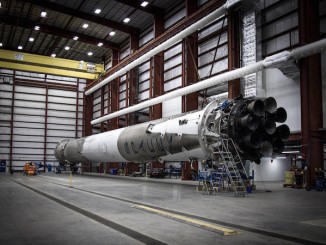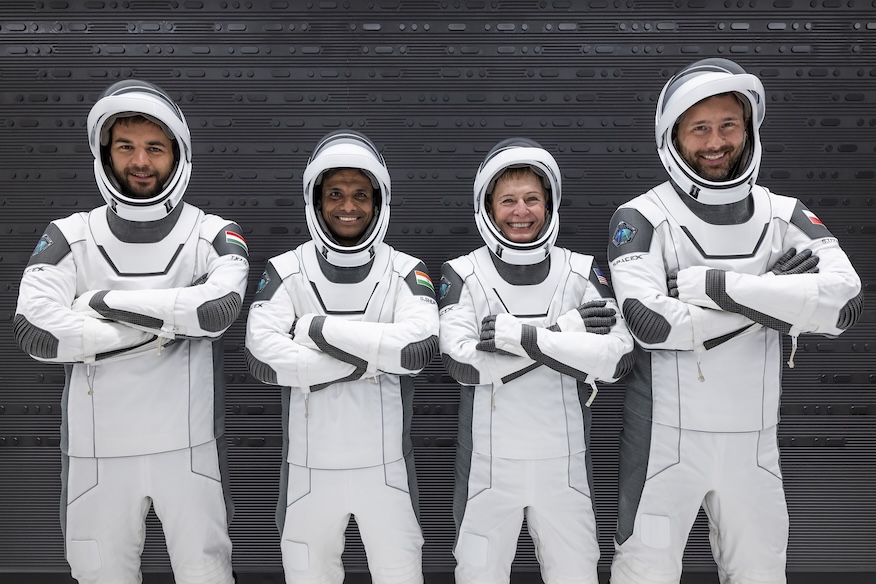
Update June 24, 6:38 p.m. EDT: Axiom Space, NASA and SpaceX are targeting Wednesday, June 25 for the mission launch.
Axiom Space is on verge of its fourth private astronaut mission to space in as many years. The flight, dubbed Axiom Mission 4 (Ax-4), will see the astronauts from India, Poland and Hungary reach the International Space Station for the first time.
The four crew members, led by Axiom Space’s Director of Human Spaceflight, Peggy Whitson, will embark on a roughly two-week mission to the orbiting outpost. The quartet will launch onboard a SpaceX Falcon 9 rocket from NASA’s Kennedy Space Center following a launch delay due to a liquid oxygen leak on the booster and then a pressure issue onboard the space station.
Liftoff on Wednesday, June 25 is set for 2:31 a.m. EDT (0631 UTC) from Launch Complex 39A.
Spaceflight Now will have live coverage beginning about five hours prior to liftoff.
The mission first slipped a day due to poor weather along the East Coast of the United States where the Dragon capsule would splashdown in the event of an abort. Weather for Tuesday morning’s launch window shows a 90 percent chance for favorable weather with a small chance for interference from scattered rain showers.
In addition to having to delay the mission because of a liquid oxygen leak found during a static fire test earlier this month, the mission was previously delayed from late May because the mission’s brand new Crew Dragon spacecraft was not ready. SpaceX performed a wet dress rehearsal tanking test days after the leak was discovered to verify the repairs worked.
During a prelaunch teleconference, William Gerstenmaier, the vice president of Build and Flight Reliability, said during the static fire test, they discovered a leak in the first stage booster, tail number B1094, that cropped back up after first seeing it during the landing of the booster on the Starlink 12-10 mission in late April.
“We’ve gone out to the launch pad. We’re continuing to troubleshoot that. We should get that completed today (Monday) and we will have that back in configuration,” Gerstenmaier said. “We’re installing a purge that will essentially mitigate the leak, if it still continues, if we see it on launch day. So we will be fully ready to go fly.”
He said they also there was also a thrust vector control problem on the booster’s engine five, which required a component swap.
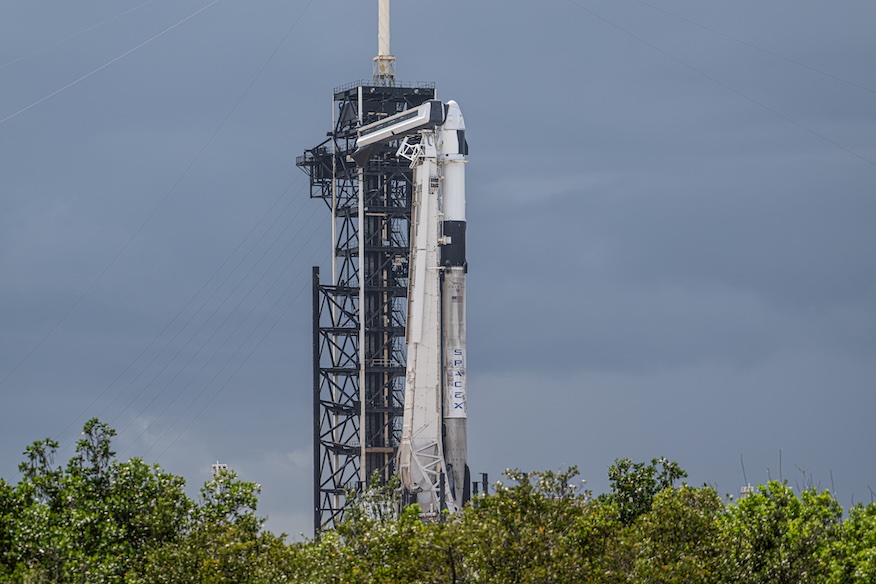
On Tuesday night, shortly before 9 p.m. EDT (0100 UTC), SpaceX posted on social media and stated that they were scrubbing Wednesday’s launch attempt “to allow additional time for SpaceX teams to repair the LOX leak identified during post static fire booster inspections.”
“Once complete – and pending Range availability – we will share a new launch date,” SpaceX wrote.
Axiom gave this mission the tagline “Realizing the Return”, since it marks the first time in 40 or more years that an astronaut from Hungary, India or Poland has been to space.
“Through this commercial space opportunity, we are accelerating the national space programs in each of these three countries and creating new pathways for technological advancements,” Whitson said. “In addition, I’m sure this crew is going to be inspiring a whole new generation of young people.”
The crew will conduct more than 60 experiments during their time in orbit, ranging from life science to technology demonstrations to diabetes research.
Ax-4 will also feature the first flight of the Crew Dragon spacecraft, tail number C213. During a prelaunch press conference, Whitson said the crew would reveal the chosen name for the spacecraft once it was on orbit. In her remarks, she hinted that the vehicle’s name is connected to their chosen microgravity indicator: a plush swan named ‘Joy.’
“The reason we selected a swan might become more obvious once you hear the name of the vehicle,” Whitson said.
Meet the crew
Whitson is no stranger to space or the International Space Station. The recent inductee into the Astronaut Hall of Fame had her first six-month mission aboard the orbiting outpost in 2002 after being selected as an astronaut candidate by NASA in 1996. Before that, she worked as a biochemist at NASA’s Johnson Space Center in Houston, Texas.
Ax-4 will be her fifth trip to space and will further cement her record for the most accumulated time spent in space by an American.
This flight will also be her second time serving as commander of a Private Astronaut Mission, the formal title given to these visiting missions, which need prior approval by NASA and the other partner nations supporting the space station.
Whitson said Axiom Space has been working to refine its astronaut training program over the course of these past four years and three prior missions.
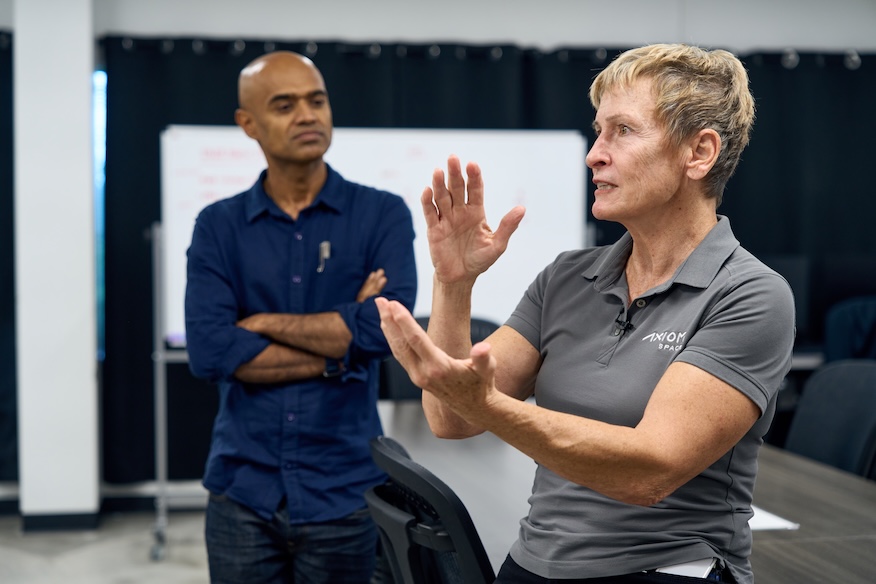
“We have continually honed and changed our training. We want to optimize that and I feel like if we’re not changing the training as we go along, we’re not adapting and supporting our objectives,” Whitson said.
“For us, obviously, those objectives, that training that we do, not only with the crew, but with all our ground teams, is so important for our end goal, which is Axiom Station, which we hope to have as a free flyer by no later than 2028,” she added. “We’re really looking forward to all those contributions that will seamlessly put is into Axiom Station as a full up and functional vehicle at that time.”
Assembly of the Axiom Station will begin by launching the Axiom Payload Power Thermal Module, which will initially berth at the International Space Station before it separates and is joined by Habitat Module One, which will include crew quarters and space for initial research and manufacturing capabilities.
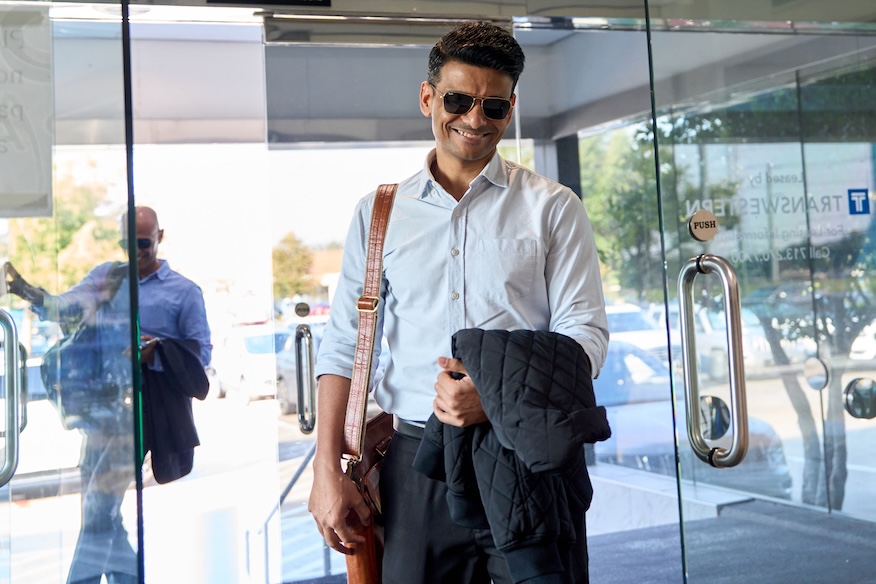
The Ax-4 pilot is Group Captain Shubhanshu Shukla, a member of the Indian Air Force for more than 15 years and one of four men selected in 2020 to participate in India’s first human spaceflight program, called Gaganyaan.
Shukla, who goes by the call sign ‘Shuks,’ said he grew up reading about the first Indian astronaut, Rakesh Sharma, who flew to space in 1984 on a Russian Soyuz spacecraft. That was a year before he was born.
Shukla said Sharma was intricately involved with the work of the Indian Space Research Organisation when it came to establishing the Gaganyaan program, selecting its astronauts and creating a training regimen.
“He is really intertwined in the proceedings of the human spaceflight mission that we were already executing and we regularly keep in touch,” Shukla said. “He is kind of a mentor for me, who is advising me on a lot of things, of what to expect, how to prepare for this particular mission.”
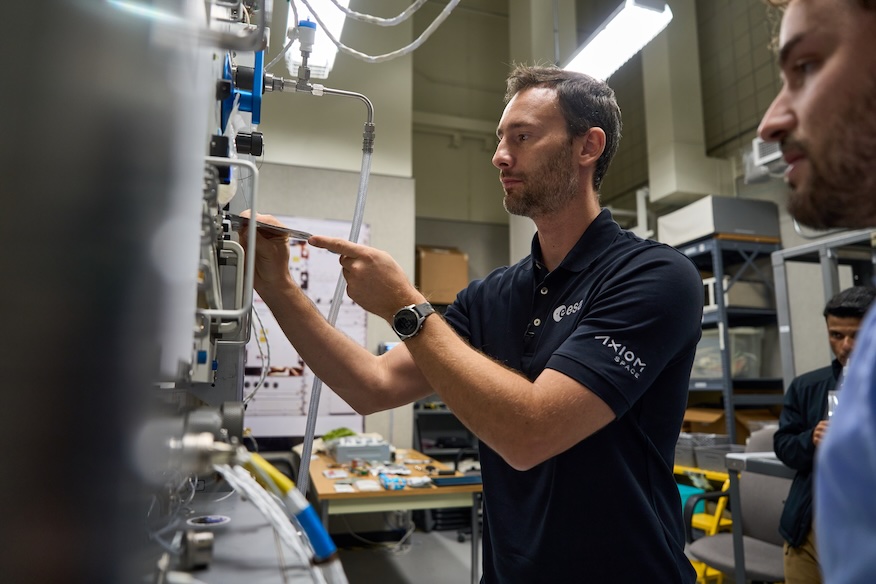
One of the two mission specialists on board Ax-4 is Sławosz Uznański-Wiśniewski from Poland, who goes by the call sign, ‘Słow.’ He was an engineer working on the Large Hadron Collider at the European Organization for Nuclear Research (CERN) when he was selected as a member of the European Space Agency’s Astronaut Reserve Class of 2022.
He’s the second Astronaut Reserve member to head to the space station following Marcus Wandt’s flight as a member of the 2024 Ax-3 mission.
Uznański-Wiśniewski is following in the footsteps of Mirosław Hermaszewski, the first and so far only Polish astronaut to go to space. He launched on the Soyuz 30 flight in the late 70s and died at the age of 81 in 2022.
“He saw my selection and I have a special connection with him. I know he supported me a lot during my selection process,” Uznański-Wiśniewski said. “He was the first person to call me back the morning after the selection to congratulate me.”
Uznański-Wiśniewski will tie the two missions together by flying the Polish flag that was on Hermaszewski’s spacesuit in 1978.
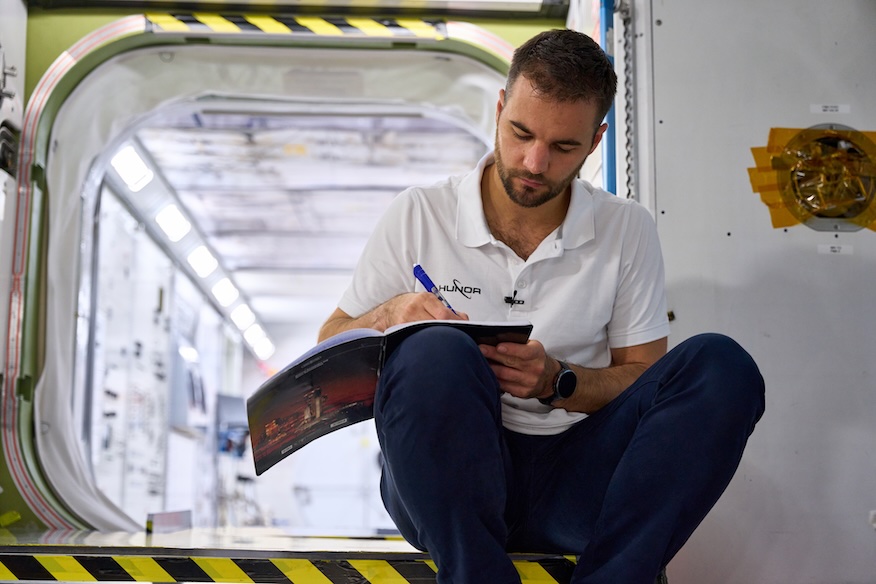
The second mission specialist flying to the space station is Hungarian astronaut Tibor Kapu. After following in his father’s footsteps by becoming a mechanical engineer, Kapu turned his sights to work on space radiation protection for an aerospace company.
That was in 2022 and by the next year, he was one of a handful of Hungarians tapped to train as an astronaut as part of the Hungarian to Orbit (HUNOR) Astronaut Program. Kapu is the first member of the program to head to space.
He said following up on the work that other Hungarians have done in the realm of space research as well as to become the second Hungarian astronaut to go to space after Bertalan Farkas’ flight in 1980 is an immense privilege.
“I think reentering this stage is a huge thing for us. We will accelerate Hungarian science and research,” Kapu said. “Our missions, I think I can speak for the other guys as well, are designed to spark excitement in younger generations. This is my personal motivation: to inspire them.”
Among the personal effects that he’s bringing up to the ISS, Kapu said he will take a tile from one of his favorite board games, Tantrix. It’s a hexagonal tile-based game created in 1988 that involves matching various lines and loops.
“It’s a logical game and I really love it,” Kapu said. “Because we have the weight limitations and volume limitations, I can actually bring one tile, so I’m planning to do that.”

